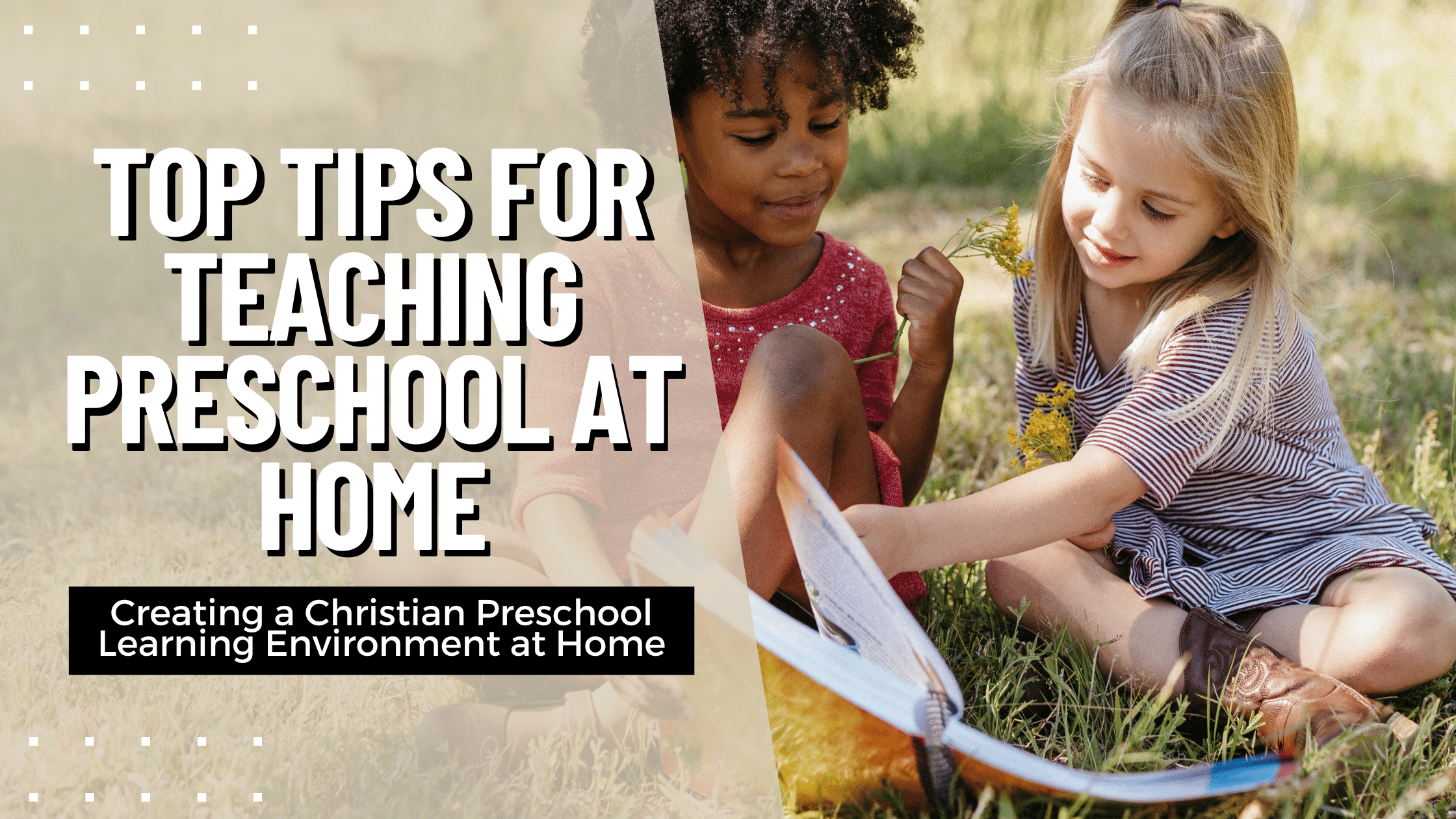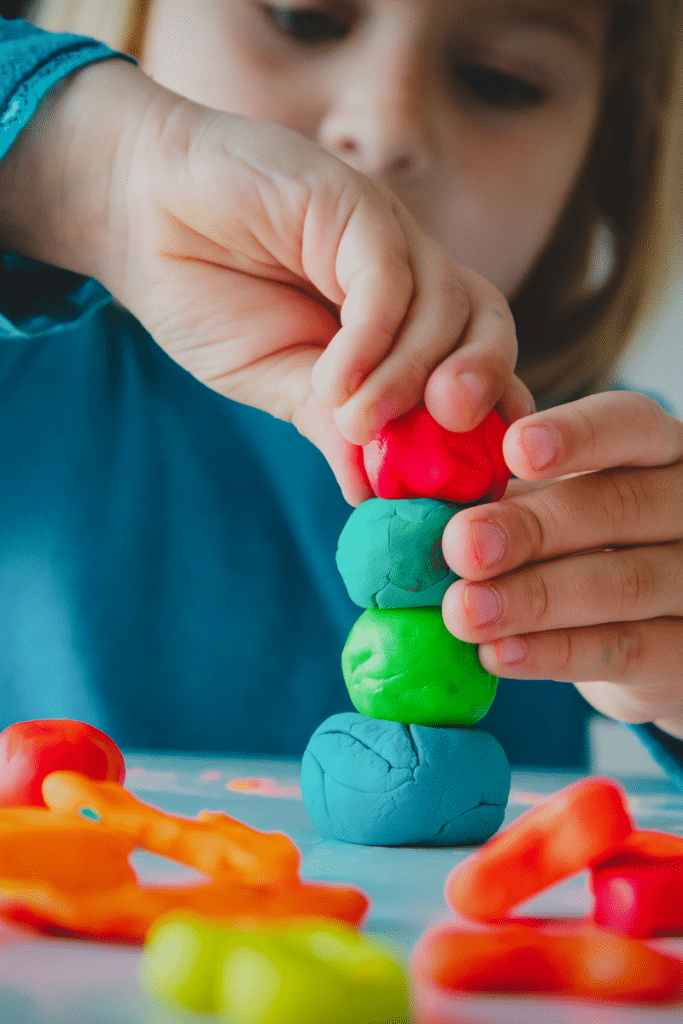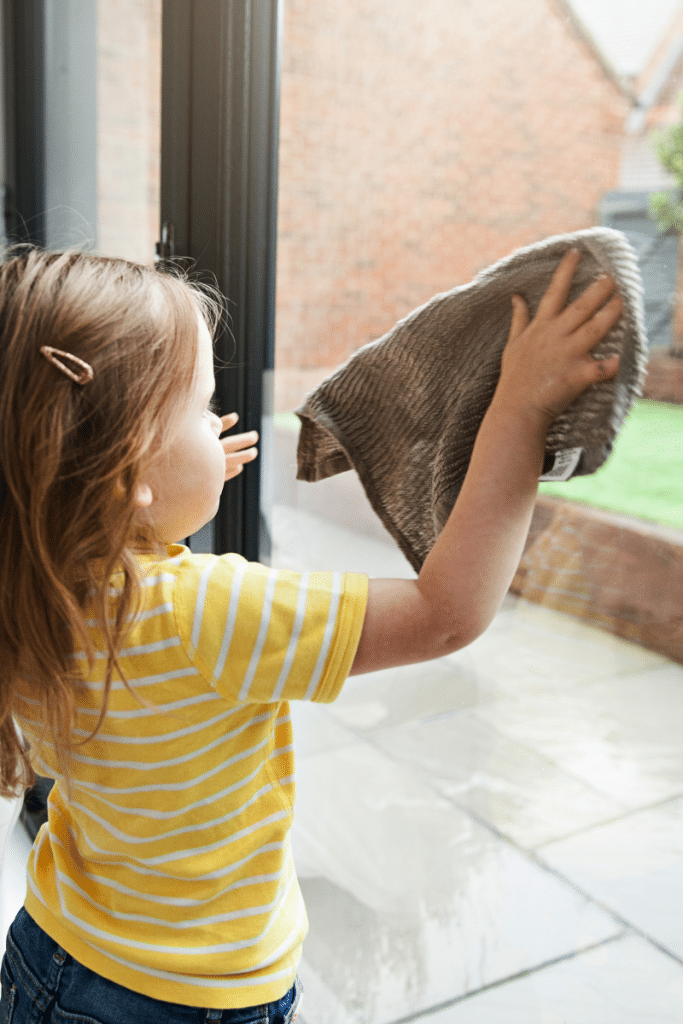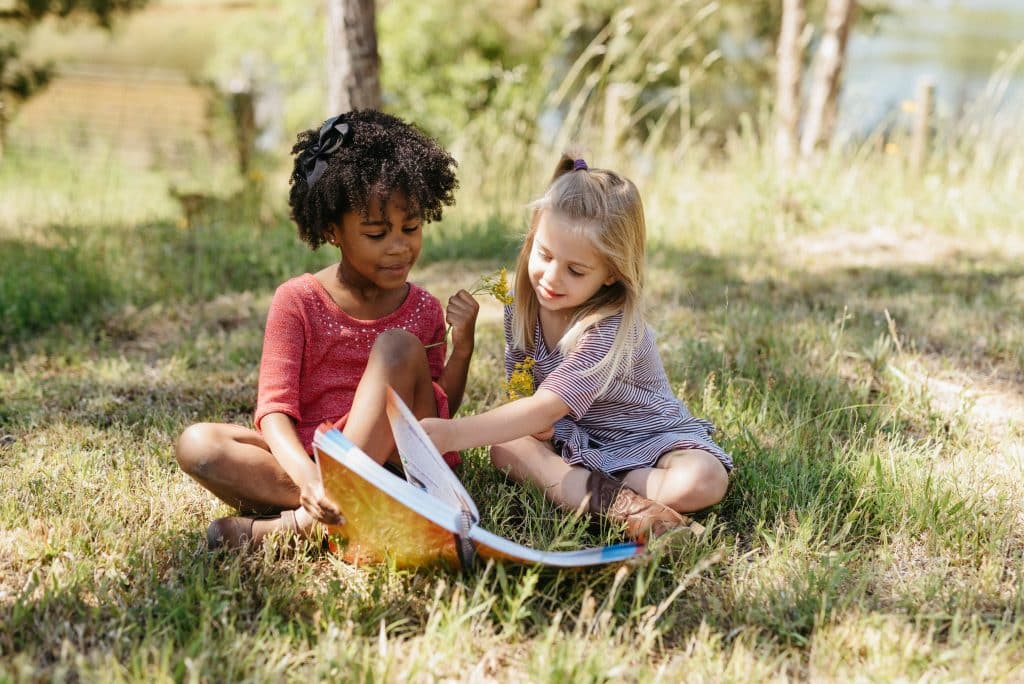
Teaching Preschool at Home: Top Tips for Creating a Christian Preschool Learning Environment at Home
Are you looking into homeschooling preschool? Here are top tips for teaching preschool at home!
Did you know that a baby giraffe stands minutes after being born? Within an hour, it can run. But God didn’t create humankind to live like the animal kingdom, and I’m grateful we don’t need to be born ready to run from predators. Likewise, as a homeschooling parent, you don’t need to rush to establish a curricular routine for your toddler either.
There’s a reason these years are called preschool; it’s pre–school. You might even describe the early learning years as your preschool child conquering the unknown through thought, trial and error, and determination. Your job of teaching preschool at home is to encourage exploration within the safe environment you’ve created, and your home is the safest place for your child’s world to be explored and expanded. So, lose your worries about formally teaching your toddler and, instead, create a mindset of upgrading your little one’s learning space (your home) with simple, fun items and learning ideas to engage your little explorer!
Children are born with a natural ability to learn. You can see the bonds instilled by God being strengthened between parents and newborns as they interact with each other. Every moment in a newborn’s life is about nourishing a tiny body, growing an incredible mind, and nurturing a beautiful soul. Your child’s preschool years can be filled with understanding that gratitude and kindness are a way of life. Furthermore, homeschooling preschoolers in an intentional Christian environment creates a firm foundation on which you can build your child’s worldview.
We will not hide them from their children, but tell to the coming generation the glorious deeds of the Lord, and His might, and the wonders that He has done. –Psalm 78:4

Create a Positive Learning Environment & Routine
There are many things to consider when creating your child’s learning environment. The main thing to consider, however, is access. Keep items that are safe and available for a curious mind within your child’s reach. Allowing a preschool child to explore on his or her terms instills in them a sense of control.
Reachable objects also create an environment where screentime is very limited. You don’t need to digitally occupy your child’s mind when his or her imagination is free to fill the time! Apologia’s preschool ideas encourage an environment that has hands-on, minds-on, and hearts-on activities that develop the most vital learning tools your child possesses–unique God-given talents and abilities.
You might even want to separate easily accessible items designated for quiet time for when you need time to work, playtime items for when the sounds of laughter will not interfere with other things happening in your home, and items nearby and ready for interactive time when you are observing, interacting, and directing your preschool child’s play.
Types of Playtime for Preschool at Home

Quiet Time
Quiet time items could include sturdy, colorful books your child can easily manipulate and a comfortable bean bag chair or pillows for snuggling. Add stuffed animals for imaginary play and blocks for building. And don’t forget the benefits of puzzles! While something might look like a simple bead maze to an adult, but if one is put in front of a preschooler, they can spend a lot of time mastering eye/hand coordination.
Playtime
Playtime items could include play kitchens, play tools, ball pits, dress-up clothing, etc. These things also add to your child’s education, but be prepared for laughter and imagination to come bubbling out during this type of playtime.
Interactive Time
Interactive time is most likely when you can direct the learning. Here, curriculum ideas and manipulatives are a fun way to interact. Think of art supplies, alphabets, numbers, snap-together electronics, and science experiments. And don’t confine yourself to your home. God created a whole world out there waiting for your child to embrace it.
Schedules & Organization for Teaching Preschool at Home
Organizing your materials and resources can be done using shelving, bins, baskets, and any system that works in your home. Be sure to consider that any designated space is safe and child-friendly. Anything your child can reach should be safe for them to play with at any time, even if you are not around to monitor them.
Wall Space
Don’t forget the wall space! You can make or purchase items to promote learning without too much effort. Numbers, letters, colors, shapes, and maps are great ideas to post around your home. Is your preschooler fascinated with rockets? Post pictures of them around the house! Have a favorite Bible story? Create a storyboard that can be visited often.
Consider purchasing a simple calendar to promote learning the months of the year and days of the week. You can even buy some weather stickers, have your child evaluate the weather, and add a daily sticker to the calendar to grow their vocabulary (cloudy, windy, rainy, snowy, etc.). You can even integrate discussions on how to dress for the day, the season, holidays, or celebrations. Just reviewing the calendar for two minutes a day promotes so much learning.

Planning Skills
Your child’s day could start informally by visiting the calendar to see what is planned for the day. Are there any activities or field trips planned for the day? What’s the weather outside? How should your child dress? Letting your child see a calendar of events can help him or her learn basic planning and predictability skills. And remember those different types of play? Will there be any quiet or interactive time scheduled within the day’s playtime? These are informal ways to introduce time management skills.
Chores
Young children love to help, contribute to the family, and feel useful. Consider having a chore chart that lets your child know what tasks he or she needs to complete each day. Even simple tasks foster confidence, and allowing your child to complete a task in his or her own time develops an important sense of independence.
Choosing Age-Appropriate Curriculum and Resources
Balancing time between play and structured learning can be easily managed if your home is set up as a learning environment.
Providing Help Where Needed
When you intentionally teach preschool at home, you realize that your child will ask for assistance when needed. Giving your child the space and time to explore, try, succeed, and even fail lets them know that you believe they are capable of trying something on their own. It lets them develop their own learning style. Take the time to model how to use the bathroom and wash up. Give your child the items (like a stepstool) to succeed, and let them try. It’s okay if they need help, but again, it’s important that they have the time and space to try.
Choosing Resources
Hands-on learning and exploration are very important during the preschool years. Children between the ages of three and five are typically working on their fine motor skills. Fortunately, there are plenty of fun and educational hands-on activities to do with your child. And with a little creativity, you can use multiple items in your preschool environment for different purposes. You can add many simple things to your home environment to promote this type of learning.
Puzzles are great! They can teach eye/hand coordination and specific recognition, such as letters of the alphabet or numbers. But don’t just keep simple one-sitting puzzles in your homeschool. Consider some larger puzzles that take time to finish. Give your child time to return to it and learn patience and perseverance.
Coloring, cutting, pasting, playdough, and any other materials that encourage hands-on learning are also great activities to help your preschooler master fine motor control skills.
Sensory bins can be used for sounds, colors, and touch. Preschoolers can sort bins filled with different types of dried beans. A bin of rice and a scoop can help them learn about different volumes. Have your child separate their blocks by color, size, or shape. Get creative and fill bins with items that fit the skill you want to teach.
You can also include items such as an abacus, bead mazes, trains, modeling dough, building blocks, buttons, snaps, and laces.
Choosing Curriculum for Teaching Preschool at Home
Since children at this age interact, imagine, and explore, making your home environment hands-on and language-rich is easy if you choose a preschool curriculum with age-appropriate activities. It’s important that any curriculum you bring into your home honors your family’s time together. It should also be written in a manner that allows your preschooler the time to grasp concepts and solve problems on his or her own.
Look for a curriculum that:
- Supports time spent together
- Parent-led (rather than dictated by the curriculum)
- Encourages time outside
- Works with a preschooler’s endless level of energy
At this age, it’s really about exposure to concepts rather than memorizing facts.
Creating a Learning Environment for Teaching Preschool
 Expand your homeschool. You’ve chosen the beauty of homeschooling over the brick-and-mortar option. So, don’t limit your child’s education to staying within the walls of your home. Art museums teach children about beauty, nature museums teach children about plants and animals, and science museums encourage children to discover how their world works. Walking outside and spending time in your own backyard will help your child grasp the changing seasons. Looking at the moon and night sky will help them grasp time. Time spent at parks, playgrounds, farms, zoos, the beach, the mountains, forests, or any other outdoor space will help them observe the variety God created in our world.
Expand your homeschool. You’ve chosen the beauty of homeschooling over the brick-and-mortar option. So, don’t limit your child’s education to staying within the walls of your home. Art museums teach children about beauty, nature museums teach children about plants and animals, and science museums encourage children to discover how their world works. Walking outside and spending time in your own backyard will help your child grasp the changing seasons. Looking at the moon and night sky will help them grasp time. Time spent at parks, playgrounds, farms, zoos, the beach, the mountains, forests, or any other outdoor space will help them observe the variety God created in our world.
Incorporate Play-Based Learning
As a parent, you can help guide your child’s learning by watching for opportunities to mentor in the moment by using open-ended questions that require a response beyond yes or no. Encourage your child to think aloud so that you can hear his or her thought process and give your child the vocabulary to describe the world. Dads seem to have an innate ability to master this point. Learning in the moment and having fun while you’re doing it promotes a lifelong love of learning. Every now and then, take a step back and make sure you are balancing play and structured learning.
Encouraging Social and Emotional Development
A great way to consider teaching your preschooler healthy and emotional development skills is through everyday life experiences. Preschoolers watch and learn from your interaction with the world, and they will normalize that behavior. If your child sees you enjoying tasks, he or she will want to participate.
Interact With and Include Them
When possible, give your preschooler your complete attention. Make eye contact and smile when working with them; you’re modeling cues for them to interact with others.
Take the time to explain the world to your child. Intentionally including your child will take longer than completing a task and moving on, but your child can gain valuable skills by including them. Letting them have a chance to ask questions is important, too. Interact with them to learn what they are observing and what answers they think they can supply.
Language
Use descriptive words so your child will learn how to describe his or her feelings about a situation. This will help your preschooler feel comfortable when you are not present. Always be aware of your word choices and tone of voice when interacting with or around your child. You’re setting the foundations for how they will learn to interact with the world.
Plenty of Christian books are waiting to find their way into your homeschool. Reading stories together can open up discussion and help your preschooler relate to the world. Model for your child how to speak in complete sentences, and use a variety of words to express the same thing so that your child’s word bank expands. Let your preschooler ponder the stories you read, and never rush the questions your child asks.
Logic
Help your child learn to follow simple directions. You can start with one-step directions and work your way up to multi-step directions, which will help your preschooler grasp logic.
Fostering a Love for Reading
Developing early literacy skills is really about creating a rich literary environment. It can be from the shelves of your home, a friend’s or family’s home, or even the library. But read, read, read to your children.
The younger your child reads, the sooner the entire world becomes accessible to them. Post the alphabet in every way, shape, and form you can find. Send your child on scavenger hunts to find things in your home that begin with the sounds of each letter.
Letters form the words we use, and words are how we communicate. Get started early by helping your preschooler make the connections. Flashcards, either store-bought or homemade, are a great way to introduce simple word recognition. Keep several types easily accessible so your child can review shapes, numbers, sight words, etc. Choose books labeled with simple images and point out the words and images to your child.
Designate a book bag exclusively for library days. Let your child browse the children’s section and pick various topics to explore that week. Take them to story time at the library. Even little children can learn how to hold a book and follow the story from the left page to the right one.
Teaching Basic Science Concepts
At the preschool (and kindergarten) level(s), science is all about exposure, not memorizing facts. It’s about helping children recognize that their world is discoverable. Through guided exploration, students learn how to naturally incorporate aspects of language (expanding vocabulary), math (counting and recording), science (observing and experimenting), and art (drawing out ideas) into their understanding of how their world works.
Apologia’s preschool course Preschool Science: Exploring Creation Together has all you need in one book. It is designed to engage your child in the fun of science exploration. The goals are exposure and wonder!
 There are seven age-appropriate chapters written in a colorful storybook format that you can snuggle up and read with your child. And you can always rest assured that Apologia has included God-honoring content as you explore creation together!
There are seven age-appropriate chapters written in a colorful storybook format that you can snuggle up and read with your child. And you can always rest assured that Apologia has included God-honoring content as you explore creation together!
There’s an included parent guide written for you so that you can guide your child and ensure that your child’s heart and mind are engaged. We’ve done the work for you so you can enjoy the “aha moments” that come with discovery.
Activities that relate to the story portion of the curriculum are designated with an icon. The Parent Guide of Preschool Science: Exploring Creation Together gives information about what your preschool child is learning in the story and the activities associated with the concepts, including the items needed and step-by-step instructions.
There’s even an art project titled “Window to My World” that winds its way through the curriculum. Preschoolers decorate a trifold poster board to create open window shutters to the child’s world. As your child learns about different science concepts, he or she will add materials to the open window.
Seeking Support and Resources
No human being is born into this world alone. You should never feel like you need to succeed at homeschooling your preschooler without help. There are many support groups that you can join in person or online.
Apologia offers curriculum, podcasts, blogs, and live support for homeschooling families. We believe in helping homeschoolers in any way we can. Learn more by exploring our website at staging.apologia.com. May your family always be blessed with joy on this journey!



